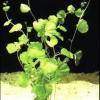Armoracia aquatica
Scientific name: Armoracia aquatica
Family: Brassicaceae
Usual maximum size in aquariums: 0 - 8 cm (0 - 3.15 inch)
014
Recommended pH range for the species: 5.5 - 7.2
Recommended water hardness (dGH): 12 - 18°N (214.29 - 321.43ppm)
0°C 32°F30°C 86°F
Recommended temperature: 18 - 25 °C (64.4 - 77°F)
Reproduction of the plant: Cuttings
Origin (in the wild): North America
How fast these plants grow: Normal
Recommended substrate: Fine gravel
Demands on lighting: Bright
Ideal placement in a fish tank: Foreground
Family
Brassicaceae
Common Name
Armoracia aquatica is known as Lake Cress.
Origin
North America, they are mostly found in the state of Ohio.
Planting Area
Midground to foreground are best places for this plant.
Lighting Requirements
These plants will require bright lighting.
Propagation
Although this plant will produce seeds they are usually not fertile and new plants cannot be propagated from them. They are normally propagated by cuttings which are easy to take as the stems will break away from the mother plant quite easily. When the cutting has been taken, cut back to form a clean slice and this can then be placed into the substrate.
Difficulty
Easy as long as they receive the correct lighting requirements.
Short Description
Armoracia aquatica is not a sturdy plant and the leaf stems are very fragile, the slightest knock can detach them, this has proved useful in their natural habitat as the lose stems help to establish new colonies of this plant. Wild colonies of this plant are in decline as their natural habitat is being developed.

 Cardamine lyrata
Cardamine lyrata